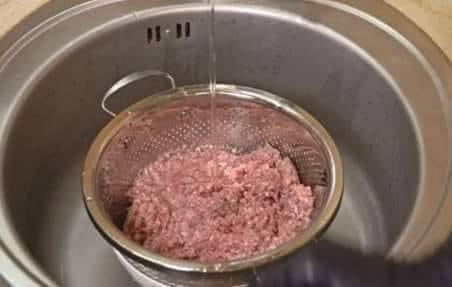
When it comes to cooking ground beef, there’s a question that has baffled many home cooks: should you wash it before cooking? It’s a practice that has sparked plenty of debate in kitchens around the world. Some believe that washing ground beef helps remove excess fat and impurities, while others argue that it’s unnecessary and could lead to potential food safety concerns.
In this article, we’ll explore the truth behind washing ground beef before cooking, debunk common myths, and provide expert advice on how to handle ground beef properly to ensure delicious, safe, and perfectly cooked meals.
Why Would You Want to Wash Ground Beef?
The idea of washing ground beef stems from a common belief that it helps remove excess fat, bacteria, or impurities that may be present in the meat. Some people may also think that washing helps the meat cook more evenly or improves the texture of the cooked dish. But does washing really make a difference? Let’s take a closer look at the pros and cons.
Possible Benefits of Washing Ground Beef
- Removing Excess Fat: It’s true that ground beef can sometimes be fatty, and many home cooks believe that washing it under cold water will help remove some of this fat. However, while rinsing the beef might remove some surface fat, it doesn’t remove the internal fat that’s mixed into the meat during the grinding process.
- Cleaning Impurities: Some people wash their ground beef to remove any blood or bits of connective tissue that might have been left behind during the grinding process. While rinsing might remove some of these impurities, it’s important to note that most reputable butchers and meat processors ensure their ground beef is clean before packaging.
Why You Shouldn’t Wash Ground Beef
While the intention behind washing ground beef is often to improve its quality, there are significant downsides to this practice that you should be aware of:
- Risk of Cross-Contamination: Washing ground beef can lead to the spread of bacteria, such as E. coli or Salmonella, that may be present in the meat. When you rinse meat under water, any bacteria on the surface can splash onto your sink, countertops, or other utensils, potentially contaminating your kitchen. The Centers for Disease Control and Prevention (CDC) specifically advises against washing raw meat for this reason.
- Loss of Flavor: By rinsing ground beef, you can actually remove some of the natural juices that contribute to its flavor. These juices are rich in flavor and essential for keeping the meat moist while cooking. Washing ground beef could result in a drier, less flavorful dish.
- Nutrient Loss: Along with losing flavor, rinsing meat can also wash away some of its nutrients. The water can strip away soluble vitamins and minerals that are naturally present in the meat.
- Ineffective Fat Removal: If your goal is to reduce the fat content of your ground beef, washing it won’t be the most effective method. Most of the fat is mixed into the meat, not just sitting on the surface. Instead, you can opt for leaner cuts of beef or drain the fat after cooking to achieve a similar result.
What Is the Best Way to Handle Ground Beef?
Now that we know washing ground beef isn’t the best approach, let’s talk about how to handle ground beef properly to ensure safety and optimal flavor:
1. Choose the Right Cut of Beef
If you’re concerned about fat content, choose leaner ground beef options. Ground beef typically comes in different fat-to-lean ratios, such as 80/20 (80% lean, 20% fat), 85/15, or even 90/10. Opting for a leaner cut can help reduce the fat in your dish without the need to wash the meat.
2. Cook Thoroughly
Proper cooking is key to ensuring that ground beef is safe to eat. The USDA recommends cooking ground beef to an internal temperature of 160°F (71°C) to kill any harmful bacteria that may be present. Use a meat thermometer to check the temperature and ensure the beef is fully cooked.
3. Drain the Fat After Cooking
If you’re looking to reduce the fat content, the best way to do it is by draining the fat after cooking the beef. Simply cook the beef in a skillet over medium heat, and once it’s browned, tilt the pan to drain the excess fat. You can also use paper towels to blot any remaining grease. This method allows you to control the fat content without losing any flavor or nutrients.
4. Store and Handle Ground Beef Properly
It’s important to handle raw ground beef with care to avoid contamination. Always store it in the refrigerator or freezer as soon as possible after purchase. If you’re not cooking the beef immediately, freeze it for future use. When preparing ground beef, make sure to wash your hands, utensils, and surfaces thoroughly to avoid cross-contamination.
The Bottom Line: Should You Wash Ground Beef?
So, should you wash ground beef before cooking it? The short answer is no. While the idea of rinsing ground beef to remove fat or impurities may seem appealing, it can actually lead to more harm than good. Washing can cause bacteria to spread, remove flavor and nutrients, and ultimately result in a less tasty meal.
Instead, focus on choosing the right cut of beef, cooking it to the proper temperature, and draining excess fat after cooking. By following these steps, you’ll be able to enjoy flavorful, safe ground beef every time.
Final Thoughts
While it’s tempting to think that washing ground beef will make it cleaner and healthier, it’s actually a step you can skip to avoid cross-contamination and preserve the flavor and nutrients of the meat. The best approach is to choose lean cuts, cook the beef thoroughly, and drain any excess fat after cooking. This will help you create a safe, flavorful dish without any unnecessary steps.
Next time you’re cooking ground beef, skip the rinse and follow these tips for a perfect, delicious meal!



